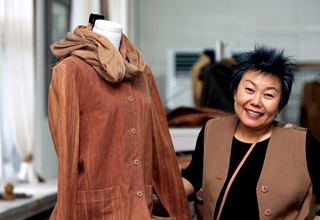
- Updated 2024.4.16 17:33
- All Articles
-
member
icon
-
facebook
cursor
-
twitter
cursor
|
Art&CultureHeritage |
Secrets of persimmon-dyed cloth revealedFashion designer returned to Jeju, and traditional craft |
|
| |
 |
|
| ▲ Yards of cloth dyed a distinctive orange with the juice of persimmons dries on the lawn of Mongsengee, which creates the traditional Jeju cloth. |
On a sunny day the old schoolyard at Mungsengee outside Hallim is a colorful visual tumble of cloth in shades of white, pink, orange, purples and greys against the lush green background. It looks more like a giant outdoor art exhibit than the thriving business it is. At Mungsengee you can learn about the Jeju tradition of persimmon dyeing, participate in the process, and meet the vibrant president and artist, Yang Soon Ja.
Trained in fashion design in New York, Yang Soon Ja learned the art of persimmon dyeing as a girl from her Jeju grandmother. Using persimmons to dye the Jeju work clothes or Galot has been practiced for over 500 years and Yang is eager to preserve the tradition. The process of dyeing the persimmon clothes, Yang explains, has three basic steps.
First, Yang harvests and buys the small Jeju persimmon fruits from locals in August to make the dye. The unripe green persimmons are crushed into juice or pulp and stored in freezers for use throughout the year.
Second, the cloth is soaked in the persimmon juice “dye.” Yang uses a variety of natural cloths including cotton, linen and silk. The cloth is soaked for about five minutes. This is still done by hand (or foot) to make sure the cloth is evenly and well coated. Participants in the dyeing experience get to squish the yellow persimmon pulp into the cloth. At this stage the cloth is a yellow color.
Lastly, the cloth is carefully stretched and laid out on the grass in the sun in the schoolyard. Because the sun is the most important element in the dyeing it is only possible to do this on sunny days. The Mongsengee crew spends cloudy days at work sewing and designing clothes and other indoor tasks.
| |
 |
|
| ▲The fabric dying process often involves feet as well as hands. Bottom right: Mongsengee owner Yang Soon Ja shows off an item of “Galot,” traditional clothing dyed with persimmons. Photos courtesy Mongsengee |
The cloth is left in the sun all day and must be turned over as well so both sides are exposed to the sunlight. When the cloth is about 80 percent dry it is hung on clotheslines to dry completely. After one day the cloth will be a pinkish yellow color. To achieve the deep orange the cloth must be left in the sun about five to seven days. Each new day the cloth is soaked in water then left to dry. Cloth can be resoaked in the dye for a darker color.
Natural persimmon dyes are not only beautiful but practical. Yang notes that her Jeju ancestors wisely used persimmons for their Galot work clothes. Persimmon-dyed clothing resists insects, has anti-bacterial qualities, is odor resistant, stays cool in the humid summer weather and even acts as sun protection. Traditionally, Jeju houses had a persimmon tree to use for their own dyeing.
Yang Soon Ja spent 15 years in New York city as a fashion designer before returning to Jeju in the late 1980's. She believed that the old craft of persimmon dyeing would be the perfect blend of her love of Jeju culture and her background in fashion design. Her enthusiasm for the art is evident as she talks about her company and the history of persimmon dyeing on Jeju. She founded her Mongsengee brand in 1996. The name, she explained, is the old Jeju word for pony and her logo is a pony head.
Yang has won many awards including a Certificate of Grand Master of Galchun craftwork in 2006. She is also constantly experimenting with new natural dyes. Besides persimmons she also uses mugwort, volcanic ash, and local flowers to name a few. She is also always looking for new products and new designs. Besides clothing Yang makes many other items including dog clothes, purses, lamp shades, wallpaper and book covers.
For more information on how to do your own persimmon dyeing visit Mongsengee online at www.mongsengee.com, call 064-796-8285 or email mong0950@hanmail.net.
|
|
|
|
|
|
|
|
ⓒ Jeju Weekly 2009 (http://www.jejuweekly.net)
All materials on this site are protected under the Korean Copyright Law and may not be reproduced, distributed, transmitted, displayed, published without the prior consent of Jeju Weekly. |
|
|
|
|
| Jeju-Asia's No.1 for Cruise |
|
|
|
Title:The jeju Weekly(제주위클리) | Mail to editor@jejuweekly.net | Phone: +82-64-724-7776 Fax: +82-64-724-7796
#503, 36-1, Seogwang-ro, Jeju-si, Jeju-do, Korea, 63148
Registration Number: Jeju, Ah01158(제주,아01158) | Date of Registration: November 10,2022 | Publisher&Editor : Hee Tak Ko | Youth policy: Hee Tak Ko
Copyright ⓒ 2009 All materials on this site are protected under the Korean Copyright Law and may not be reproduced, distributed, transmitted, displayed, published
without the prior consent of jeju weekly.com.

|






















